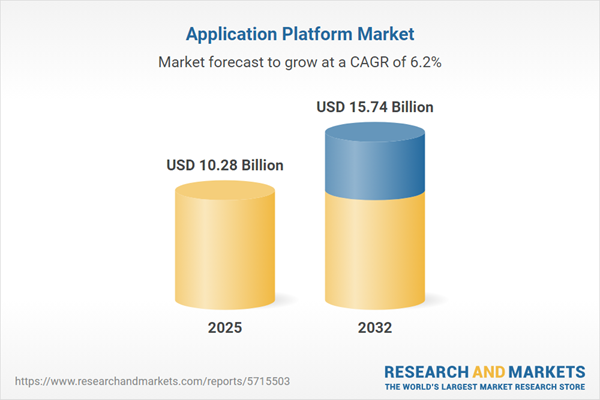Speak directly to the analyst to clarify any post sales queries you may have.
The application platform market has rapidly evolved to become integral to enterprise digital transformation strategies. Senior decision-makers face an increasingly complex landscape where robust platforms drive operational agility, accelerate innovation, and secure regulatory compliance.
Market Snapshot: Application Platform Market Size & Growth
The application platform market grew from USD 9.70 billion in 2024 to USD 10.28 billion in 2025 and is projected to reach USD 15.74 billion by 2032, reflecting a CAGR of 6.23%. This steady expansion underscores the rising demand for scalable and flexible platform solutions across diverse enterprise environments.
Scope & Segmentation of the Application Platform Market
This research comprehensively analyzes the global application platform landscape through detailed segmentation, technology trends, and deployment models to equip leaders with actionable perspectives.
- Component: Service (consulting, deployment & integration, support & maintenance); Software.
- Type: Cloud-based platforms, low-code/no-code platforms, mobile application platforms, web application platforms.
- Application: Custom application development, customer relationship management, enterprise resource planning, marketing & sales automation, supply chain management.
- User Type: Business users, personal users.
- Industry Vertical: Banking, financial services & insurance; education; energy & utilities; healthcare; retail & e-commerce; telecom & IT.
- Deployment Mode: Cloud-based, on-premise.
- Geography: Americas (United States, Canada, Mexico, Brazil, Argentina, Chile, Colombia, Peru); Europe, Middle East & Africa (United Kingdom, Germany, France, Russia, Italy, Spain, Netherlands, Sweden, Poland, Switzerland, United Arab Emirates, Saudi Arabia, Qatar, Turkey, Israel, South Africa, Nigeria, Egypt, Kenya); Asia-Pacific (China, India, Japan, Australia, South Korea, Indonesia, Thailand, Malaysia, Singapore, Taiwan).
- Key Companies: Accenture, Adobe, Akamai Technologies, Appian, Atos, Betty Blocks, Birlasoft, BMC Software, Capgemini, Caucho Technology, CGI, Cisco Systems, Cognizant, F5, GigaSpaces Technologies, Google, Hewlett Packard Enterprise, Hitachi, Infosys, IBM, Micro Focus, Microsoft, Optimajet, Oracle, Perforce Software, Salesforce, SAP, Siemens, Temenos, Wipro.
Key Takeaways for Decision-Makers
- Application platforms now act as key facilitators for rapid innovation, unifying diverse development methodologies while supporting modularity, governance, and compliance initiatives.
- Enterprises are leveraging cloud-native frameworks and integrating AI or low-code functionalities to enhance development velocity and minimize dependence on specialized IT talent.
- Vendors emphasize mobile-first and omnichannel capabilities, ensuring seamless user experiences while providing tools for responsive design and broad integration across enterprise systems.
- Growing regulatory requirements and cross-border data flow concerns are shaping platform investment decisions, especially in sectors such as BFSI and healthcare.
- Strategic partnerships, co-development alliances, and ecosystem-centric delivery models empower organizations to increase market agility and reduce risks linked to supplier concentration or shifting regulatory landscapes.
- Consolidation and adaptive pricing frameworks are emerging as responses to heightened procurement scrutiny and new tariffs, resulting in new market entry and expansion opportunities.
Impact of United States Tariffs on Market Value Chains
The recent implementation of stringent U.S. tariffs has affected supply chain dynamics for application platforms. Hardware cost increases are leading organizations to reconsider sourcing and nearshoring strategies, while software vendors adjust licensing and billing models to maintain competitiveness. These tariffs have escalated compliance challenges and increased procurement complexity, triggering collaboration among governments and suppliers to secure critical technology flows and mitigate delays in project delivery.
Research Methodology & Data Sources
This analysis relies on in-depth primary interviews with senior industry stakeholders, complemented by robust secondary research of white papers, technical documentation, regulatory guidelines, and media reports. Meticulous validation steps, including triangulation, ensure all findings reflect the real-world situation. Quality controls and peer review processes reinforce accuracy and credibility throughout the research lifecycle.
Why This Report Matters
- Enables executives to benchmark application platform choices and build future-proof digital transformation strategies aligned with emerging technology trends.
- Delivers regional and industry-level intelligence to tailor market entry, product positioning, and sourcing decisions, factoring in evolving regulatory and tariff landscapes.
- Provides a clear strategic framework to inform platform selection, vendor partnerships, and investment roadmaps amid market disruption and innovation cycles.
Conclusion
Carefully selected application platform strategies empower organizations to increase innovation, ensure operational resilience, and navigate shifting regulatory and supply chain pressures. This report highlights the pathways and partnerships critical to building sustained competitive advantages in a complex digital environment.
Additional Product Information:
- Purchase of this report includes 1 year online access with quarterly updates.
- This report can be updated on request. Please contact our Customer Experience team using the Ask a Question widget on our website.
Table of Contents
3. Executive Summary
4. Market Overview
7. Cumulative Impact of Artificial Intelligence 2025
Companies Mentioned
The companies profiled in this Application Platform market report include:- Accenture Plc
- Adobe Inc.
- Akamai Technologies Inc.
- Appian Corporation
- Atos SE
- Betty Blocks B.V.
- Birlasoft Limited
- BMC Software Inc.
- Capgemini SE
- Caucho Technology Inc.
- CGI Inc.
- Cisco Systems Inc.
- Cognizant Technology Solutions Corp.
- F5, Inc.
- GigaSpaces Technologies Inc.
- Google LLC by Alphabet Inc.
- Hewlett Packard Enterprise Development LP
- Hitachi Ltd.
- Infosys Ltd.
- International Business Machines Corporation
- Micro Focus International PLC
- Microsoft Corporation
- Optimajet Limited
- Oracle Corporation
- Perforce Software Inc.
- Salesforce Inc.
- SAP SE
- Siemens AG
- Temenos AG
- Wipro Ltd.
Table Information
| Report Attribute | Details |
|---|---|
| No. of Pages | 198 |
| Published | November 2025 |
| Forecast Period | 2025 - 2032 |
| Estimated Market Value ( USD | $ 10.28 Billion |
| Forecasted Market Value ( USD | $ 15.74 Billion |
| Compound Annual Growth Rate | 6.2% |
| Regions Covered | Global |
| No. of Companies Mentioned | 31 |









